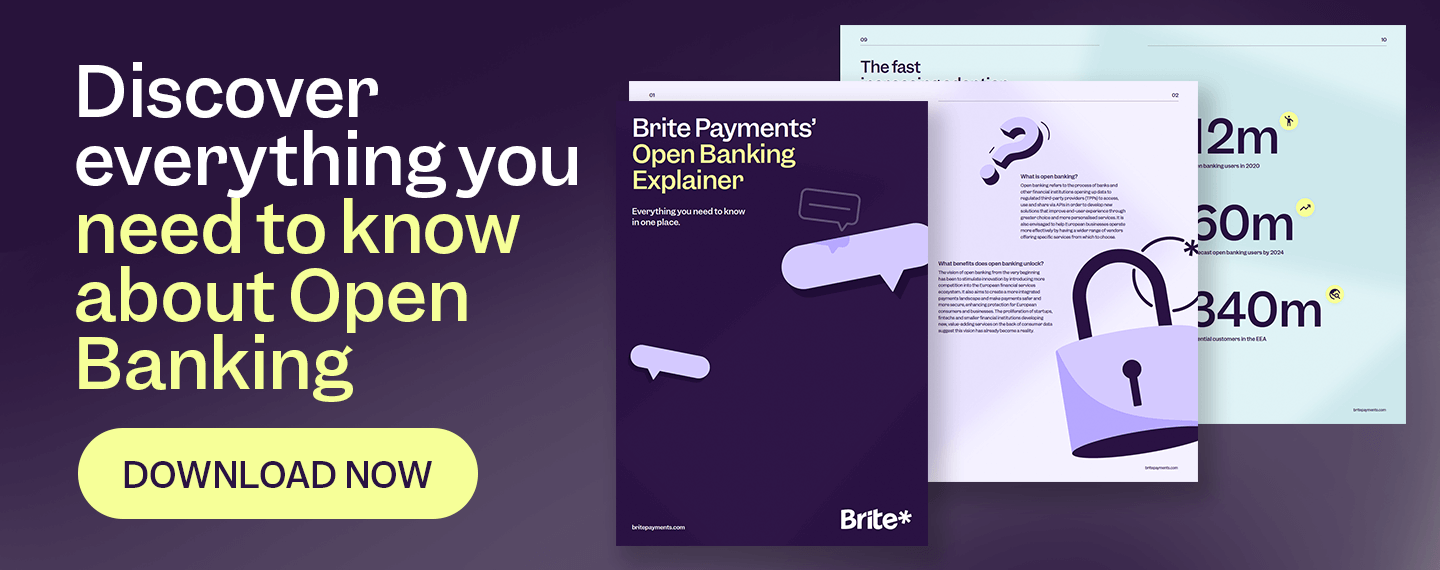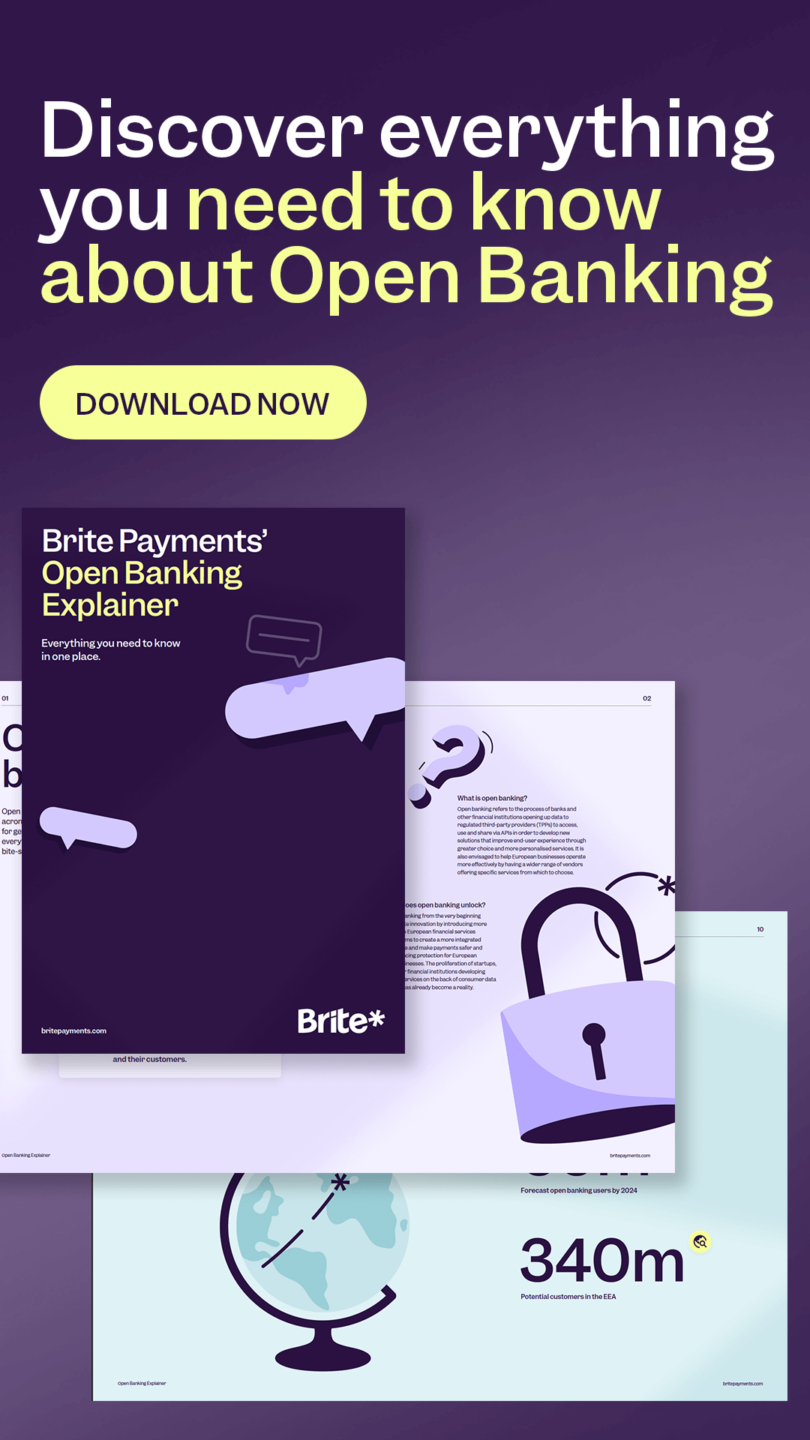Curious about open banking? You’ll love our explainer

Download our explainer to get a better understanding of:
- What open banking is
- Who the main actors are in the open banking ecosystem
- How instant payments improve the payment landscape
- How instant payments can give your company a competitive advantage
What is open banking?
Open banking is a relatively new financial system that enables individuals and businesses to securely share financial information with authorised third-party payment providers (TPPs), such as Brite. This includes data related to bank accounts and transactions. Banks and financial institutions provide application programming interfaces (APIs) to facilitate this sharing.
The primary objective of open banking is to promote competition, innovation, and consumer choice in the financial industry. With a customer’s consent, third-party financial service providers, such as fintech companies, can access and utilise their financial data. This data can be used to create new financial products and services, offer personalised financial advice, streamline payments, and improve overall financial management.
Open banking works worldwide and is gaining momentum, driven by regulatory initiatives and the desire to offer consumers more choice and convenience in managing their finances. It has the potential to disrupt traditional banking models, encourage competition, and lead to the development of innovative financial solutions tailored to individual needs.
Want to know more? Download the explainer to get a full and complete picture of open banking.
What are the key open banking solutions?
There are a range of open banking services which consumers and business alike can benefit from. Below is a list of some of the main initiatives powered by open banking APIs.
Data sharing
Customers can grant permission for TPPs to access their banking data, such as account balances, transaction history, and payment details.
Payment initiation service (PIS)
Open banking allows TPPs to initiate payments directly from a customer’s bank account, making online transactions more efficient. Companies that provide account information services are often referred to as payment initiation service providers (PISPs).
Account information service (AIS)
Third-party providers can aggregate financial information from multiple bank accounts, providing customers with a comprehensive view of their finances in one place. Companies that provide these services are often referred to as account initiation service providers (AISPs).
Innovation
Open banking fosters innovation by enabling developers to create new financial applications and services that leverage banking data. For example, apps that help the user to budget and save more easily.
Security
Security and data protection are paramount too. Strict regulations, such as the European Union’s General Data Protection Regulation (GDPR), as well as Strong Customer Authentication (SCA), and the newly unveiled Payment Service Regulation (PSR), are in place to ensure the safe and secure handling of customer data.
Read more about different models of open banking payment models in our recent article.
How does open banking make money?
Companies that work within open banking infrastructures make their money in various ways. For example, they may charge a subscription fee for merchants to use account information services via apps. Or, similar to traditional payment providers, such as credit card providers, they charge a transaction fee – except at a far lower cost due to the less complex and more efficient dynamics of payment initiation services. Additionally, many traditional banks, and other payment providers, collaborate with TPPs to provide unique and innovative services for customers.
Is open banking safe?
Within open banking security is high on the agenda. Indeed, one of the benefits being pushed by open banking is full control over financial data for individual consumers. For example. A consumer can choose which data to share and with whom to share it. And if they change their mind, you can revoke access anytime.
Additionally, open banking platforms, such as TPPs, use and follow a high-level of open banking API security. Indeed access to account data ins only performed through secure APIs that use real-time data exchanges.
Plus, in regulated markets like Europe, third-party providers must also register with national regulatory agencies, ensuring data protection and the ability to control access. They must also follow set rules such as strong customer authentication and new methodologies such as IBAN checking.
Open banking trends around the World
What is open banking in the EU?
Open banking is a concept that emerged from the European Union’s Payment Services Directive 2 (PSD2) – see our recent PSD3 explainer for more info. This directive expanded access to account and payment information for third-party providers, laying the foundation for EU-wide open banking standards as we know them today.
Bringing payments into the 21st century
It was a response to changing European consumer expectations, driven by the user-friendly experiences offered by tech giants like Amazon, Facebook, and Netflix, as well as the convenience of mobile apps.
Open banking results from three key factors: customer demand for innovative financial services, technological advancements, and favourable regulations. It has revolutionised the financial industry by making it more accessible and competitive, reducing reliance on traditional banks. Today, open banking-powered account-to-account payments are changing how consumers and merchants pay and get paid.
Today, open banking fosters collaboration between traditional institutions and fintech startups, offering consumers a broader range of financial products and services tailored to their evolving needs. What’s more, open banking sets the stage for the next evolution of finance across Europe: open finance.
The power and reach of open banking payments
At the forefront of open banking is the emergence and adoption of open banking payments. Open banking payments, including the instant account-to-account (A2A) payments as offered by Brite Payments (see our Instant Payments product page), are making low-cost and fast payments a reality.
These innovative payments may be displayed as a form of Pay by Bank at checkouts across Europe. One of the essential benefits of open banking-powered payments is that they are open to everyone who has access to a bank account. Therefore, the scope of these types of payment products is considerable.
Take, for example, the number of credit card holders in Europe versus the number of people who have access to a bank account in Europe:
According to the latest *World Bank data, 43% of adults in the European Economic Area (EEA) own a credit card, compared to 96% of adults in the EEA who have access to a bank account. ** In 15 European countries, including the UK, Germany, and France, as much as 99% of the population have access to a bank account, and in the Nordics, this is virtually 100% of the adult population.
The power and reach of open banking payments, such as instant A2A payments, far exceeds more traditional forms of card payment. The future of online payments across Europe is one where open banking has a big role to play.
What is open banking in the UK?
At the same time as the EU was implementing its reforms, British financial authorities were setting in motion ideas for open banking within the UK. In 2016, the Competition and Markets Authority (CMA) released a report scrutinising the state of the UK’s retail banking sector. It shed light on a concerning trend. Established banks needed to face more competitive pressure to earn and retain customers, while newer banks and payment providers struggled to break into the UK market. To address this competition deficit, one of the CMA’s key recommendations was the introduction of open banking in the UK.
Fast forward to 2018, and the open banking ecosystem began to come into play. Like within the EU, this new framework empowers customers and UK small-to-medium enterprises (SMEs) to securely share their current account information with third-party payment providers. This shift marked a significant step in the quest for more competitive and consumer-centric banking within the UK.
What is open banking in the US?
Regulatory challenges of open banking
In the United States, open banking takes on a distinct character. Unlike other world regions, such as Europe, with clear regulatory frameworks, e.g. PSD2, open banking initiatives here are primarily industry-led. Innovative fintech companies actively seek access to individuals’ financial data to provide them with tailored and improved financial services. Simultaneously, traditional banks, recognising the commercial opportunity, have taken the initiative to develop services that allow their customers to share their data securely.
This dual approach has its challenges, considering the complex regulatory landscape in the US, which involves multiple federal and state-level regulatory bodies. In the US, congressional legislation and regulatory standardisation are essential when establishing nationwide standards, and this is important given the use of open banking data.

